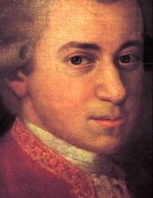
Two more last Symphonies at the RFH Mozart's last Symphony, no.41(nicknamed the 'Jupiter', though not by
Mozart) was composed in 1788, three years before his death, so it doesn't
represent any 'last thoughts' the way that Bruckner's and Mahler's last
symphonies may do. It is a masterly display of techinque, including some
chromatic and contrapuntal passages which were innovative for the time, and
carries a more serious weight than much of Mozart's earlier work. Yesterday
evening's performance by the Royal Philharmonic Orchestra, conducted by Daniele
Gatti, seemed little muted to begin with, partly because of the usual problem of
an over-sized string section and modern woodwind instruments failing to cut
through the sound, so that the result was less clear and articulated than Mozart
would have expected. By the final movement the performance had warmed up and the
movement's twists and turns were well conveyed and with more
sparkle.
Mozart's last Symphony, no.41(nicknamed the 'Jupiter', though not by
Mozart) was composed in 1788, three years before his death, so it doesn't
represent any 'last thoughts' the way that Bruckner's and Mahler's last
symphonies may do. It is a masterly display of techinque, including some
chromatic and contrapuntal passages which were innovative for the time, and
carries a more serious weight than much of Mozart's earlier work. Yesterday
evening's performance by the Royal Philharmonic Orchestra, conducted by Daniele
Gatti, seemed little muted to begin with, partly because of the usual problem of
an over-sized string section and modern woodwind instruments failing to cut
through the sound, so that the result was less clear and articulated than Mozart
would have expected. By the final movement the performance had warmed up and the
movement's twists and turns were well conveyed and with more
sparkle. Beethoven's last completed symphony, his 9th (sketches survive for a tenth which have
been worked into a performing version) must have seemed quite extraordinary for
the period ((1824): the orchestra is large even by modern standards, plus four
soloists and a choir in the final movement, and the work runs for over an hour -
all unheard of at the time. Beethoven continued the innovations of Haydn and
Mozart in the development of the symphony form from its polite beginnings and
laid the groundwork for the massive works to come from Bruckner, Mahler and
others. Each of the first three movements follows in general terms the
established formats - sonata form, a scherzo, and a slow movement, but
stretching the format to its limits and developing thematic ideas in a much more
complex way than had been accepted. The final movement - itself running longer
than many symphonies of the previous century - is the famous setting of words
drawn from Schiller's Ode To Joy: the well-known
theme is subjected to a number of variations (including an impression of a
military band) and finishes with a glorious vocal outpouring - taken last night
with a speed and precision which made it truly exciting and captured some of the
revelation that must have accompanied its first performances. It's one of the
best-known works in musical history, but still captures the emotions and
imagination. Beethoven's last completed symphony, his 9th (sketches survive for a tenth which have
been worked into a performing version) must have seemed quite extraordinary for
the period ((1824): the orchestra is large even by modern standards, plus four
soloists and a choir in the final movement, and the work runs for over an hour -
all unheard of at the time. Beethoven continued the innovations of Haydn and
Mozart in the development of the symphony form from its polite beginnings and
laid the groundwork for the massive works to come from Bruckner, Mahler and
others. Each of the first three movements follows in general terms the
established formats - sonata form, a scherzo, and a slow movement, but
stretching the format to its limits and developing thematic ideas in a much more
complex way than had been accepted. The final movement - itself running longer
than many symphonies of the previous century - is the famous setting of words
drawn from Schiller's Ode To Joy: the well-known
theme is subjected to a number of variations (including an impression of a
military band) and finishes with a glorious vocal outpouring - taken last night
with a speed and precision which made it truly exciting and captured some of the
revelation that must have accompanied its first performances. It's one of the
best-known works in musical history, but still captures the emotions and
imagination.Posted: Thu - March 19, 2009 at 09:47 AM by Roger Wilmut |
Quick Links
About Me:
Roger Wilmut XML/RSS Feed
MY PODCAST
Archives
Calendar
Blogroll
WEBRINGS
Statistics
Total entries in this category: Published On: Mar 11, 2016 05:00 PM |
||||||||||||||||||


